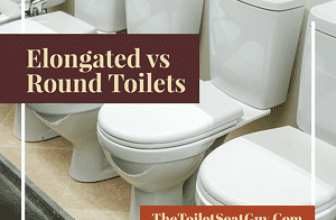
Choosing the best type of toilet for your bathroom isn’t as easy as picking the right color and design. There are many little differences between toilets that make the choice that little bit more complicated. Do you want a round or elongated bowl. Would you prefer a one-piece or a two-piece toilet. Maybe a Comfort Height toilet will be a better size for you, over a standard height unit.
Well of course, we have to compare another two types of toilets: Dual and Single Flush. This Dual Flush vs Single Flush toilet comparison guide, will show you the similarities and differences between these two types of toilets. After reading this article, you may have narrowed down your search for which type of toilet will be the ideal choice for your bathroom.
Here is our Best Dual Flush Toilet Reviews
What Is A Dual Flush Toilet?
A Dual Flush toilet is an alternative to the Single Flush version. The difference between the two is that the Dual Flush gives the user a choice of two different amounts of water. Although flushing toilets have been around since the 16th century, dual flushing toilets are more of a modern creation. The first real dual flush toilet was created in 1980 and from then has evolved into a very efficient flushing system.
How Do Dual Flush Toilets Work?
A standard Single Flush system will use a siphoning mechanism to pull water and waste down into the drain. However, a high volume of water is needed to perform this action effectively. On the other hand, Dual Flush systems use gravity to remove waste from the toilet. With a combination of gravity, a larger trapway and the push down flushing system, Dual Flush toilets are capable of using less water, compared to Single Flush models.
Dual Flush toilets have two flushing amounts to choose from. There is a half flush for liquid waste and a full flush for solid waste. Generally, activating the flushing mechanism is a result of either pressing one of two buttons or by flushing with the handle. The handle mechanism normally works by holding down the handle for a full flush, where as a quick release of the handle will provide a semi flush.
On average, a standard toilet used 3.5 Gallons Per Flush, where as the first Dual Flush toilet used 3 GPF for a full flush and 1.5 GPF for a half flush. Of course, at the time this helped make significant savings on water use. However, as technology and design has improved, modern Dual Flush toilets have evolved to use as little 1.6 GPF for a full flush and 0.9 GPF for a semi flush.
Dual Flush vs Single Flush Toilets: Quick Comparison Guide
Do Dual Flush Toilets Save Money?

Since water costs money, and a Dual Flush toilet will use less water than a standard Single Flush model, then of course a Dual Flush toilet will save money. But the question is, how much money will you be able to save.
According to the Environmental Protection Agency, the average home will save roughly 13,000 gallons of water per year, just by replacing old standard models with WaterSense labeled toilets. Some Single Flush units are WaterSense certified also, because using less than 1.6 GPF qualifies.
However, all modern Dual Flush toilets are WaterSense certified, so there are savings to be made. In fact, by using 13,000 gallons of water less per year, you will make a saving of roughly $130 annually.
If you were on the fence of whether a Dual Flush model is worth the higher price tag, then you can see that the water savings will pay off the extra cost of the toilet, in 1 or 2 years.
What are a Dual Flush Toilet’s Pros and Cons?
Is the Dual Flush toilet perfect? No. There have been a few downsides compared to a Single Flush unit. Here you can see the pros and cons of a Dual Flush.
- An environmentally friendly toilet that uses less water, compared to a Single Flush unit.
- Allows you to save money on water bills per year.
- Gives you a choice of two water volumes. This means there is no need to have full flushes for liquid waste.
- Due to the larger trapway, a Dual Flush model is less likely to clog, compared to a standard toilet.
- Dual Flush toilets cost more than standard toilets. However, overtime this extra cost will be eliminated, due to water savings.
- Dual Flush toilets may not flush as effectively as Single Flush toilets. In general, a Dual Flush will have less water in the bowl and will have more of a tendency to leave streak marks.
What About Modern Single Flush Toilets?
Well, so far there may have been a lot of love for Double Flush toilets. However, we shouldn’t forget modern Single Flush toilets. Single Flush toilets can be just as efficient as Dual Flush models. In fact, many modern Single Flush units are WaterSense certified and use 1.28 GPF. Compared to an old Single Flush model that used 3.5 GPF, that makes a huge difference. A WaterSense certified toilet is eco-friendly, a money saver and a necessity to have in certain American states.
Another factor to consider, is that Single Flush units are less expensive, compared to Dual Flush toilets.
However, Single Flush toilets also have their pros and cons. Lets have a quick look at them.
Single Flush Toilet Pros and Cons
- Compared to Dual Flush toilets, Single Flush units are less expensive to buy.
- They can be just as water efficient. Many modern Single Flush toilets are WaterSense certified.
- They have a better flush and are less likely to leave streak marks on the bowl.
- More aesthetically pleasing because there is more resting water in the bowl.
- Only have one choice of flush for both liquid and solid waste.
- Compared to Dual Flush toilets, more likely to clog due to smaller trapway.
- More of a selection to choose from because they are more common.
A Dual Flush vs Single Flush Toilet: Which Is Better?

Well, as you can see there are a few trade-offs between a Dual and a Single Flush toilet. What they have in common is that they both can be environmentally friendly options. Both can be WaterSense labeled, allowing you to make significant savings on water per year. However, Dual Flush toilets does give you the option of a half flush for liquid waste. A half flush can be as little as 0.8 to 0.9 GPF.
In contrast, a Dual Flush will be more expensive to purchase. Also, it has a lot less resting water in the bowl, which may not be as aesthetically pleasing to some people. A Dual Flush unit is also less likely to clog but more likely to leave streak marks. Less blockages but more toilet brush usage.
So as you can see, it is difficult to choose which toilet is better. One thing is for sure, you can find some great Dual and Single Flush toilets that are effective and efficient.
Hopefully, by reading this article on Dual Flush vs Single Flush Toilet comparisons, you have a better understanding of the similarities and differences between these two types of flushing toilets. Now, is the time to make the decision which one will be more suitable for your bathroom.






